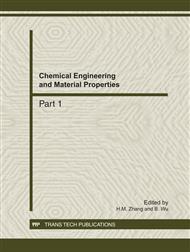p.1195
p.1200
p.1205
p.1210
p.1215
p.1220
p.1225
p.1230
p.1235
Effect of Supports on the Properties of Co-Mo Nitride Catalysts for Ammonia Decomposition
Abstract:
Supported Co–Mo nitride catalysts have been synthesized by incipient-wetness impregnation method and temperature-programmed reaction in N2-H2 mixed gases. The effect of support types, namely carbon nanotubes(CNTs), active carbon(AC), 5A zeolite and Al2O3 on the properties of the prepared catalysts for ammonia decomposition has been investigated by XRD, H2–TPR and SEM techniques. The results showed that CNTs was the optimum support for Co–Mo nitride catalyst. At 550 , NH3 conversions over CoMoNx/AC, CoMoNx/Al2O3 and CoMoNx/5A Zeolite catalysts were only 14.7%, 65.4% and 68.7%, respectively, while NH3 conversion over CoMoNx/CNTs catalyst was up to 84.4%. XRD and H2–TPR results indicated that the active species consist of CoMoO4, MoO3, γ-Mo2N and Co3Mo3N crystallites, which can be reduced at elevated temperatures at H2 atmosphere. The SEM characterization demonstrated that Co-Mo nitrides particles disperse uniformly on the CNTs.
Info:
Periodical:
Pages:
1215-1219
Citation:
Online since:
December 2011
Authors:
Keywords:
Price:
Сopyright:
© 2012 Trans Tech Publications Ltd. All Rights Reserved
Share:
Citation:


